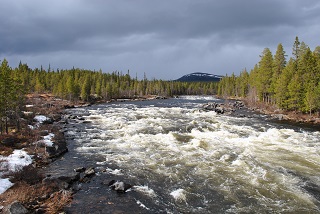A project that aims to encourage the return of wild salmon to the EU’s largest lake and an associated river system straddling the Norwegian border is, following the implementation of an ERDF-funded scheme, beginning to pay dividends.
- 27 January 2016
The overall objective of the project was to identify what needs to be done in order to save the Vänern salmon and, after that, to implement the measures necessary to boost stocks.Disseminating information and developing a close collaboration between the concerned Swedish and Norwegian actors have been two of the most important activities in the project. This will be of great importance for the future actions that are planned to take place in order to save the Vänern salmon.
Lake Vänern in south-western Sweden has been an important fishing lake for over 9 000 years and is notable for the fact that its native freshwater salmon have never entered the ocean.
The lake, which is the largest in the EU, plays host to two species of land-locked salmon, collectively known as Vänern salmon. Both strains are related to Baltic Sea salmon and are characterised by their long spawning migrations and massive size, with some having been weighed in at over 15 kilogrammes. In fact the largest lake salmon ever caught, exceeding 20 kilogrammes, was caught in Lake Vänern.
A population in decline
However, the building of a number of hydroelectric installations along the Klarälven-Trysilelva-Femundselva river system – which straddles the border between Norway and Sweden – during the course of the 20th century led to a dramatic downturn in Vänern’s once plentiful salmon. This is because the dams and power plants prevented fish from getting to their traditional spawning grounds, while some ended up being killed in power plant turbines.
It is estimated that the lake’s and river system’s salmon spawning stock is now only 5 % of what it was at the beginning of the 19th century. This fall in numbers has had a negative impact on the local area, which is highly dependent on fishing, fish-processing and angling tourism.
Casting a new approach
Since the 1930s, the natural reproduction of salmon has been maintained by moving fish to spawning areas upstream from the first power plant by trucks. This however is not a sustainable approach, so the ERDF-funded “Save the salmon in the lake of Vänern” project has drawn up an action plan to tackle the problem in a different way. This would see the building of salmon lifts and by-pass channels, allowing the adult and young salmon to circumvent the power plants in both directions.
Once the lifts and channels are built, the number of salmon returning to the lake each year is expected to rise from roughly 1 000 to 30 000. It is hoped that over the next 20 years, the Klarälven-Trysilelva-Femundselva river system will become one of the highest-yielding salmon river systems in Scandinavia, helping to support local communities economically.
Total investment and EU funding
Total investment for the project “Save the salmon in the lake of Vänern” is EUR 3 528 000, of which the EU’s European Regional Development Fund is contributing EUR 1 667 000 from the Operational Programme “Sweden Norway” for the 2007 to 2013 programming period.

